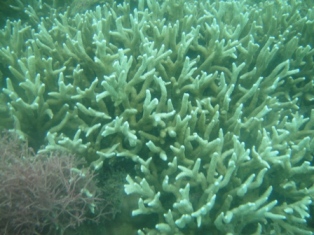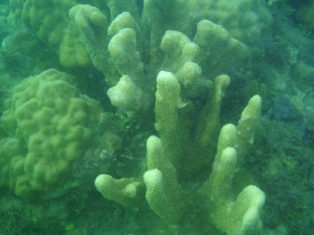 A total of sixty-nine (69) reef fish species belonging to 22 families/subfamilies were recorded in the
A total of sixty-nine (69) reef fish species belonging to 22 families/subfamilies were recorded in the reefs of Mondragon. Relatively high number of species were observed in Monbon and Pasig na Lubog (28 species) followed by Palijon (26), Pasig na Lutaw (23) while the rest of the sites had less than 20 fish species. The average fish abundance was low, ranging from 6 to 716 individuals//250m2 (average=95). Relatively high abundance was observed in Pasig na Lubog while relatively low abundance was observed in the rest of the sites. In terms of fish biomass, the values range from 1.0 to 8.7 MT/km2 (average=4.0). Relatively higher biomass was observed in Palijon (8.7 MT/km2) and Pasig na Lutaw (5.6 MT/km2), while the other sites (i.e., Pasig na Lubog, Paninirahan, Monbon, Hirapsan, and Pinguhan) had low biomass. Based on the benchmark figures established in the country, the following account describes the initial reef fish profile in Mondragon based from the different sites surveyed in the Philippines: species diversity, abundance and biomass in all sites of Mondragon falls under low category.
reefs of Mondragon. Relatively high number of species were observed in Monbon and Pasig na Lubog (28 species) followed by Palijon (26), Pasig na Lutaw (23) while the rest of the sites had less than 20 fish species. The average fish abundance was low, ranging from 6 to 716 individuals//250m2 (average=95). Relatively high abundance was observed in Pasig na Lubog while relatively low abundance was observed in the rest of the sites. In terms of fish biomass, the values range from 1.0 to 8.7 MT/km2 (average=4.0). Relatively higher biomass was observed in Palijon (8.7 MT/km2) and Pasig na Lutaw (5.6 MT/km2), while the other sites (i.e., Pasig na Lubog, Paninirahan, Monbon, Hirapsan, and Pinguhan) had low biomass. Based on the benchmark figures established in the country, the following account describes the initial reef fish profile in Mondragon based from the different sites surveyed in the Philippines: species diversity, abundance and biomass in all sites of Mondragon falls under low category.
Among the seven (7) sites surveyed, five sites were identified as having high potential to be an MPA based on the set criteria. The sites include Monbon (Rank 1), Pasig na Lubog and Pasig na Lutaw (Rank 2), Pinguhan (Rank 3), Paninirahan (Rank 4), Palijon and Hirapsan (Rank 5).
Environmental problems such as anthropogenic stress include, overfishing, siltation, collection of corals (e.g., Kangkurong reef) and white sand (e.g., Monbon Island) are the major threats on the coral reefs of Mondragon. An integrated approach to coastal resource management (CRM) is recommended to complement the MPA initiatives, and specific management plans for the MPAs are urgently needed to ensure enhanced MPA management and networking.



